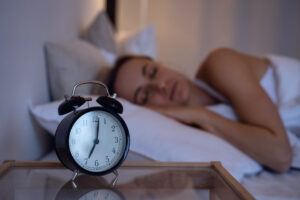When you buy through our links, we may earn a commission. Products or services may be offered by an affiliated entity. Learn more.
Tips for Sleeping During the Day
Many people follow schedules that require them to work at night and sleep during the day. While some adjust to this routine rather quickly, others experience trouble falling asleep in the daylight hours due to a mismatch between their body’s circadian rhythm and natural light cycles. Roughly 18.5% of night shift workers meet the diagnostic criteria for insomnia, compared to 8.6% of day shift workers.
Nailing down a daytime sleep routine can be quite challenging at first, but taking certain measures at home and practicing good sleep hygiene can expedite this process and help you get the right amount of rest.
Choosing a Daytime Sleep Routine
Most adults between the ages of 18 and 64 should receive at least seven hours of sleep every 24 hours. There is some wiggle room with these numbers, but we don’t recommend sleeping fewer than six hours or more than 10 hours per day.
Let’s say you work from 9 pm to 5 am five days per week. Assuming a moderate commute each way, this leaves you with 14-15 hours allotted to personal time and a few options for planning your sleep schedule.
Some night shift workers prefer to get home and stay up for a few hours before going to bed, as one might do on a traditional 9-5 work schedule. Others prefer the split-nap routine. This consists of a moderate nap immediately after arriving home, a period of wakefulness, and a longer nap in the hours before work.
Experts agree both options are effective. The key is to plan your sleep so that you wake up close to the start time of your shift. Additionally, you should strive to sleep and wake up at the same times every day, including weekends and when you’re on vacation.
If possible, ask your supervisor if you can work the same shift every day , rather than following a rotating schedule that requires you to work different hours for your shifts. With a steady schedule, your circadian rhythm will eventually adjust to the work hours. A rotating schedule forces you to readjust every few days, making it hard for your body to fall into a natural hormonal rhythm.
If you must work a rotating schedule, ask your supervisor if it’s possible to “ rotate forward ,” or rotate day to swing to night to morning shifts in that order. Your circadian rhythm will have an easier time adjusting to this natural progression, as opposed to rotating back in the opposite direction (e.g. going to bed progressively earlier instead of later) or rotating shifts in a random pattern.
Creating a Relaxing Sleep Environment
Think of your bedroom as a sleep sanctuary. You should immediately feel relaxed and ready to sleep as soon as you enter the room. The following sleep hygiene practices can help you achieve this goal:
- Block out the light: An obvious obstacle to sleeping during the day is exposure to sunlight, especially if you have multiple windows in your bedroom. Blackout curtains or other thick window coverings will prevent most outside light from entering your room. An eye mask may also be effective.
- Keep things quiet: Outside noises may be another distraction during the day. Earplugs can reduce noise-related disruptions. Alternatively, a white noise machine can drown out other sounds and help you relax.
- Maintain a comfortable sleep temperature: Whether you run hot or cold in bed, many experts agree the ideal sleep temperature is 65 degrees Fahrenheit (18.3 degrees Celsius). The body naturally cools down at night, so this temperature ensures you won’t feel too warm.
- Turn off your phone: If your job requires you to be on call at all times, then this may not be an option. Otherwise, consider turning off your cell to avoid sleep disturbances. You should also avoid looking at the phone too much before trying to sleep, as these devices emit a blue light that can make falling asleep difficult. Other devices that emit blue light include televisions, tablets, and computers.
- Talk to your housemates: Whether you live with your family or roommates, make sure everyone else under your roof understands the importance of your sleep time. Consider keeping your bedroom door closed to minimize disruptions
If you’re sleeping in a new place or a bedroom that isn’t your own, you can customize the space to some extent by bringing your own sleep accessories, such as a pillow or pajamas.
How To Prepare for Daytime Sleep
To ensure an adequate amount of rest, you should do the following at work or at home before going to sleep:
- Eat right: What, when, and how much you eat during work can impact your sleep. If you work an afternoon shift, you should have your main meal in the middle of the day – not the middle of your shift. Night shift workers, on the other hand, should consume a light amount of food during their shift and follow it up with a moderate breakfast. Regardless of your specific shift, sticking to the same mealtimes every day is also recommended.
- Watch your caffeine intake: Many night shift workers depend on caffeine to stay alert, but too much coffee or caffeinated soda can make it hard to fall asleep when you get home. A small amount near the beginning of your shift probably won’t cause any issues, but you should try to avoid caffeine up to three or four hours before your intended bedtime.
- Don’t drink after your shift: Consuming alcohol before bed can help you fall asleep more quickly. However, it can also lead to disrupted and fragmented sleep. For best results, avoid alcohol altogether if you plan to sleep during the day.
- Try napping at work: The ideal nap length lasts for . This allows you to enjoy several minutes of uninterrupted rest without falling into deep sleep, which can leave you feeling groggy and unfocused upon waking up. If your workplace doesn’t have a dedicated nap room, an unoccupied office or even your car will work in a pinch.
- Wind down when you get home: Some enjoy meditation before bed, while others prefer a warm bath or shower. Find a relaxing activity to help you calm down and prepare for sleep.
Lastly, a word about melatonin supplements. Many people take these over-the-counter sleep aids to get more rest and some people find melatonin helpful for correcting circadian rhythm issues, but you should always speak to your doctor before trying this medication. For some people, melatonin supplements have adverse effects on their sleep-wake rhythms.
References
7 Sources
-
American Academy of Sleep Medicine. (2014). The International Classification of Sleep Disorders – Third Edition (ICSD-3). Darien, IL.
https://aasm.org/ -
Belcher, R., Gumenyuk, V., & Roth, T. (2015). Insomnia in Shift Work Disorder Relates to Occupational and Neurophysiological Impairment. Journal of Clinical Sleep Medicine, 11(4).
https://pubmed.ncbi.nlm.nih.gov/25665690/ -
Consensus Conference Panel, Watson, N. F., Badr, M. S., Belenky, G., Bliwise, D. L., Buxton, O. M., Buysse, D., Dinges, D. F., Gangwisch, J., Grandner, M. A., Kushida, C., Malhotra, R. K., Martin, J. L., Patel, S. R., Quan, S. F., Tasali, E., Non-Participating Observers, Twery, M., Croft, J. B., Maher, E., … Heald, J. L. (2015). Recommended amount of sleep for a healthy adult: A joint consensus statement of the American Academy of Sleep Medicine and Sleep Research Society. Journal of Clinical Sleep Medicine, 11(6), 591–592.
https://pubmed.ncbi.nlm.nih.gov/25979105/ -
Knauth, P., & Hornberger, S. (2003). Preventive and compensatory measures for shift workers. Occupational Medicine, 53(2), 109–116.
https://academic.oup.com/occmed/article-lookup/doi/10.1093/occmed/kqg049 -
Boudreau, P., Dumont, G. A., & Boivin, D. B. (2013). Circadian Adaptation to Night Shift Work Influences Sleep, Performance, Mood and the Autonomic Modulation of the Heart. PLoS One.
https://pubmed.ncbi.nlm.nih.gov/23923024/ -
Åkerstedt, T. (1998). Is there an optimal sleep-wake pattern in shift work? Scandinavian Journal of Work, Environment & Health, 24, 18–27.
https://www.jstor.org/stable/40966833 -
Lammers-van der Holst, H. M., Murphy, A. S., Wise, J., & Duffy, J. F. (2020). Sleep tips for shift workers in the time of pandemic. Southwest Journal of Pulmonary & Critical Care, 20(4), 128–130.
https://www.ncbi.nlm.nih.gov/pmc/articles/PMC7189699/












